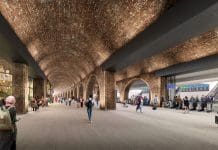Birmingham City Council has approved planning permission for two railway viaducts in the city centre which will join Curzon Street Station with the HS2 project
The Curzon Street Approach consists of four connected railway viaducts between Duddeston Junction Viaduct and Curzon Street Station. Two other viaducts, Curzon Street No.1 Viaduct and Curzon Street No.2 Viaduct, are still in the application stages.
The proposed railway viaducts, Curzon Viaduct No.3 and Lawley Middleway Viaduct, are being designed by a design joint venture of Mott MacDonald, Systra and Weston Williamson + Partners, as part of HS2’s civils contractor Balfour Beatty VINCI joint venture.
Design refinements result in a shorter construction programme for railway viaducts
Updates to the designs include reducing the width of the viaduct from 71 metres to 65 metres. The Curzon Street Pumping Station has been removed from the design as excess water will now be drained into an attenuation pond or underground tank.
The 300 metre long Curzon Viaduct No.3 will be supported by 30 concrete V piers. These have been chosen to minimise space taken up on the ground level and maximise public use of the space under the viaduct. There is also a side recess for future services to be integrated.
Paying homage to Birmingham’s canalside history
As Curzon Street No.3 Viaduct crosses the Digbeth Canal, the V piers are substituted with four inverted steel piers to reference the heritage of canal-side cranes in Birmingham.
Nick McGough, director at Weston Williamson and Partners said:
“The design maximises daylight under the structure through the introduction of light slots with a lightweight parapet design. Over the Digbeth Canal the opportunity is taken to reference Birmingham’s canalside heritage.
David Speight, client project director at HS2 Ltd said:
“We are on track to bring high-speed rail to the West Midlands, increasing capacity and connectivity across the UK. Our design refinements on the viaducts will bring a range of extra benefits, including reducing the amount of carbon on the project.”

















